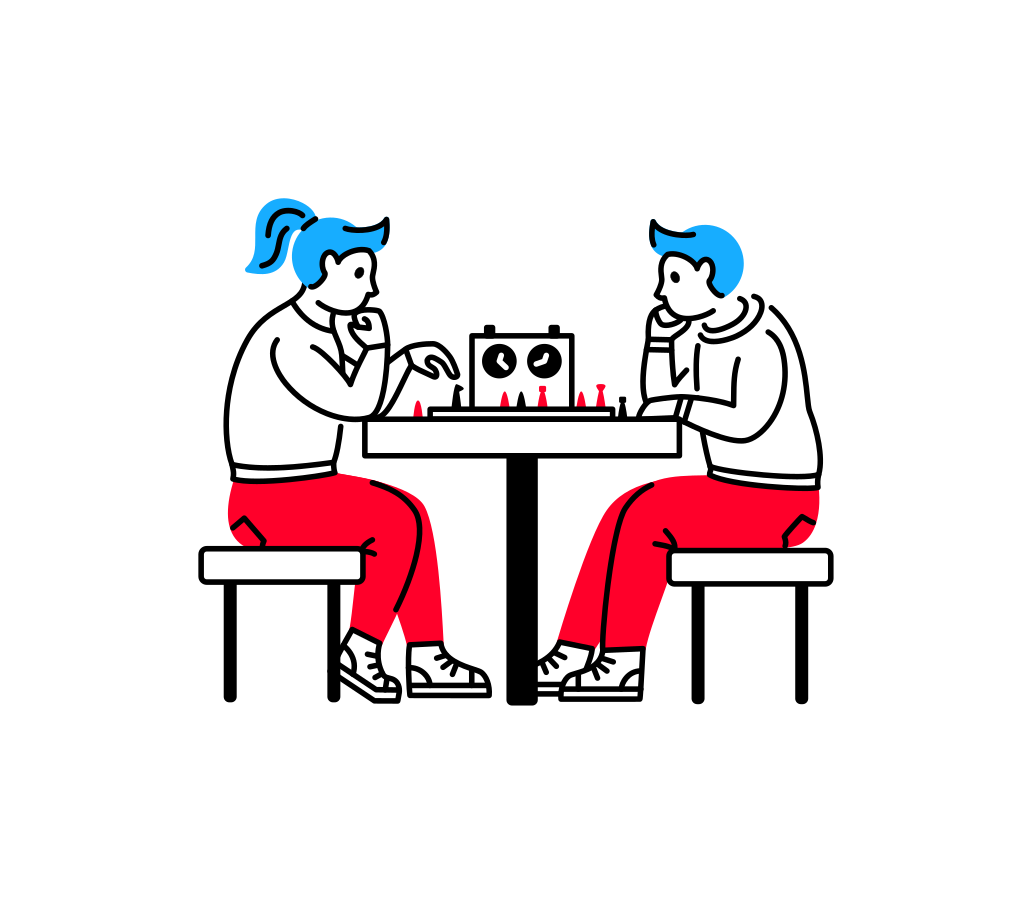Welcome to the world of chess, where each piece is a potential game-changer, and knowledge is your greatest weapon. In this mesmerizing world of chess, every move counts, every decision matters, and every piece plays a unique role. This EnthuZiastic blog explores the different types of chess pieces and their values. As we delve into the battle of chess pieces and their values, you will discover that this ancient game is more than just a pastime—it’s a masterclass in tactical thinking and foresight.
So, let’s embark on a journey to unravel the fascinating intricacies of the different types of chess pieces and their values in the game.
The Chessboard: Where the Battle Happens

Before we dive into the different types of chess pieces and their values, let’s talk about the chessboard. It’s an 8×8 grid, like a checkerboard, with alternating dark and light squares. You’ll find it in two cool colors – usually black and white. This chessboard is your battlefield, where all the chess action takes place. At the heart of this captivating battlefield stand the chess pieces, each with its distinct character and value.
Remember that ‘chess is a game of skill, strategy, and patience, making it a timeless and engaging pastime for players of all ages’. In a chess game, each player starts with 16 pieces, which include a king, queen, rooks, bishops, knights, and pawns.
Know Your Chess Army
Each player in chess starts with 16 pieces: 1 king, 1 queen, 2 rooks, 2 knights, 2 bishops, and 8 pawns. It’s like your chess army! These pieces are your buddies, and you need to use them wisely to win.

- The king moves one square in any direction
- The queen moves in any direction for multiple squares
- Rooks move in straight lines
- Bishops move diagonally
- Knights move in an L-shape
- Pawns move forward one square but capture diagonally
The key is to plan your moves, control the center of the board, protect your king, and use your pieces wisely to outmaneuver your opponent.
The King: Your Royal Highness (Value: Priceless/Infinite)
The king is the most essential piece. It’s like the king of the chess world. You win the game if you put your opponent’s king in checkmate, which means the king can’t move anywhere without being captured. Remember that the king can only move one square in any direction – up, down, sideways, or diagonally.
The king can also perform a special move called castling in tandem with the rook. It is also important to note that a King cannot be placed at a square exactly next to the opponent’s king. The opponent’s king must always be kept at a safe distance. The king can also castle when there are no pieces between the king and the rook on either side, and the king hasn’t moved to any square during the game. To add to this, the king cannot castle when under check. The king is the most important piece in chess because the goal is to win the opponent’s king.
If a your king is threatened with capture, it is said to be in check, and you must remove the threat of capture on your next move. If this cannot be done, the king is said to be in checkmate, resulting in a your game loss. You cannot make any move that places your king in check. Despite this, the king can become a solid offensive piece in the endgame or, rarely, the middlegame. The king’s value is infinite because losing the king means losing the game. Protect your king at all costs!
The Queen: The Powerful Ruler (Value: 9 points)
The queen is the most powerful and valuable piece. It can move any number of squares vertically, horizontally, or diagonally, combining the powers of the rook and bishop. It’s like your commander-in-chief. Each player starts the game with one queen, placed in the middle of the first rank next to the king. The queen is usually positioned behind the pawns and pieces during the opening. However, there are exceptions to this rule. The queen can be used for early and brutal attacks. Losing your queen can be a tough blow, so keep it safe and use it wisely.
The Rooks: The Castle Defenders (Value: 5 points each)
Rooks are like the castles of your chess kingdom. They can move in straight lines – up, down, or sideways – as far as you want, but not diagonally and may capture an enemy piece on their path.
The rook is worth about five pawns and is generally considered stronger than bishops or knights by nearly two pawns but less valuable than two minor pieces by approximately a pawn. Rooks work best when they work together, protecting each other and controlling the board.The reason the Rook is considered less valuable than two minor pieces is because it lacks mobility.

In the diagram above, the Knight, which is supposed to have a value of 3 points, is worth much more than the Rook, which is supposed to be 5 points. And why is that? Because in that specific position, the Rook has no mobility, no good squares to land on, and the Knight can jump freely from one square to another, creating a mess in Black’s position.

Additionally, they may participate in castling. A common strategic goal is to develop a rook on the first rank of an open file (i.e., one unobstructed by pawns of either player) or a half-open file (i.e., one unobstructed by friendly pawns) . From this position, the rook is relatively unexposed to risk but can exert control on every square on the file. If one file is particularly important, a player might advance one rook on it, then position the other rook behind— doubling the rooks. A rook on the seventh rank (the opponent’s second rank) is typically very powerful, threatening the opponent’s un-advanced pawns and hems in the enemy king. A rook on the seventh rank is often considered sufficient compensation for a pawn.
The Knights: The Sneaky Horses (Value: 3 points each)
Knights move uniquely. They go in an L-shape: two squares in one direction (up, down, left, or right), and then one square perpendicular to the first move. They are the only pieces that can jump over other pieces on the board. They’re like sneaky horses. Knights can jump over other pieces, which makes them great for surprise attacks.
The knight is one of the six types of chess pieces and is considered a minor piece. It is worth three points. The knight can be used to deliver a fork, which is when two or more pieces are attacked simultaneously, or even a smothered mate, which is a checkmate that occurs when a king is surrounded by their pieces and cannot move out of check.
Check out EnthuZiastic Chess Classes for a personalized Chess learning experience.
The Bishops: The Diagonal Masters (Value: 3 points each)
Bishops are like the chess ninjas on the board. They move diagonally, which means they always stay on the same-colored squares. You have two bishops on light squares and one on dark squares. Use them to control the board and create powerful attacks.
Bishops are generally considered to be more valuable than knights, especially in open positions. However, knights can be more useful in closed positions, where their ability to jump over other pieces can be an advantage. Develop your bishops early in the game. This will give them more mobility and allow them to control more squares on the board. They can be used to control important squares on the board, such as the center and open diagonals. This can make it difficult for the enemy to move their pieces and can also open new attacking lines for you.
The Pawns: The Frontline Soldiers (Value: 1 point each)
Pawns are like your frontline soldiers. They move forward one square at a time, but they capture diagonally. On their first move, pawns can move forward two squares.
The center of the board is the most important part of the board, and controlling it gives your pieces more mobility and makes it more difficult for your opponent to move their pieces. Pawns are a great way to control the center because they can move forward and capture enemy pieces. They can be used to support other, more valuable pieces, such as rooks and queens.
Pawns might seem weak, but if they reach the other side of the board, they can promote to any other piece (except another pawn). So, they can become queens, knights, rooks, bishops, or even en passant diagrams!

Chess Piece Values: How to Keep Score
Now that you know who’s who on the chessboard, let’s talk about their values. Understanding the importance of each piece can help you make smart moves and win the game.

Sometimes, a well-placed pawn can be more valuable than a misplaced queen. It all depends on the situation.
FAQs
What is the point value of a queen in chess?
The queen is the most valuable piece in chess, and it is worth 9 points.
How many points is a rook worth in a standard game of chess?
A rook is worth 5 points in chess.
What is the point value of a pawn in chess, and does it change during the game?
A pawn is initially worth 1 point in chess, but its value can increase if it successfully promotes to a higher-value piece like a queen, rook, bishop, or knight.

Learn Chess From Expert Teachers
Conclusion
Knowing the values of each piece can help you make smart moves and win the game.
- King: Priceless
- Rook: 5 points each
- Knight: 3 points each
- Bishop: 3 points each
- Pawn: 1 point each
Whether you’re a novice eager to learn the basics or an experienced player looking to deepen your understanding, our exploration of different types of chess pieces and their values will provide you with valuable insights into their roles, their worth on the board, and how to wield them effectively to outmaneuver your opponent.
Keep playing, learning, and enjoying yourself as you progress in your chess adventure because practice makes perfect. Each piece has a certain value, or importance, along with a set movement pattern, as taught in top chess courses by Fide trainer Darko Polimac.
So get out there and set up your chessboard, and may your strategic thinking lead you to victory in chess! Learn more about our chess courses!

